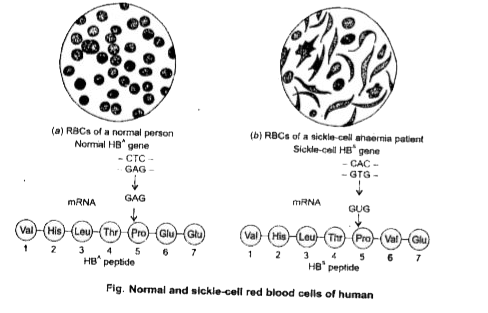Explain sickle-cell anaemia. Solution in Punjabi
Sickle-cell anaemia. (i) It is caused by a recessive mutant allele on chromosome 11. :

(ii) The affected idividuals have sickle-shaped erythrocytes with defective baemoglobin. The gene controlling the disorder has two alleles, HbAandHbB. There are three possible genotypes: HbAHbA,HbAHbsandHbsHbs. Individuals homozygous for HbsHbs suffer from the disease and die very early. (iii) Heterozygous (HbA Hb) individuals appear apparently unaffected, but they are carriers of the disease, who can pass on the disorder to the next progeny. (iv) The defect is caused by substitution of glutamic acid by valine in the sixth position of the p-polypeptide of haemoglobin, the defective haemoglobin causes the sickling of RBCs. Symptoms (i) Due to aggregation of erythrocytes in the venous capillary system, several tissues suffer severe damage because of lack of oxygen, it is also known as sickle-cell crisis. (ii) Such erythrocytes are destroyed more rapidly than the normal red blood cells and that leads to anaemia. (iii) The mutant haemoglobin undergoes polymerisation under low oxygen concentration and causes sickling of erythrocytes. (iv) The person suffocates faster in crowded places and at high altitudes.
Topper's Solved these Questions
- PRINCIPLES OF INHERITANCE AND VARIATION BOOK - BETTER CHOICE PUBLICATIONCHAPTER - PRINCIPLES OF INHERITANCE AND VARIATION EXERCISE - SHORT ANSWER TYPE QUESTIONS
66 Videos
- PRINCIPLES AND PROCESSES IN BIOTECHNOLOGY BOOK - BETTER CHOICE PUBLICATIONCHAPTER - PRINCIPLES AND PROCESSES IN BIOTECHNOLOGY EXERCISE - LONG ANSWER TYPE QUESTIONS
16 Videos
- REPRODUCTION IN ORGANISMSBOOK - BETTER CHOICE PUBLICATIONCHAPTER - REPRODUCTION IN ORGANISMSEXERCISE - LONG ANSWER TYPE QUESTIONS (5 MARKS)
11 Videos
Similar Questions
Who is responsible for the sex of the new born child. Male or Female? Explain.
View SolutionWhat is recombinant DNA technology? Explain in brief the various steps in the process of recombinant DNA technology.
View SolutionExplain various artificialmethods of vegetative propagation.
View SolutionSickle -cell anaemia is:
View SolutionSickle-cell anaemia is :
View SolutionSickle cell anaemia is an example of
View SolutionSickle cell anaemia is an example of :-
View SolutionExplain the molecular basis of Sickle Cell Anaemia.
View SolutionDescribe sickle cell anaemia.
View SolutionSickle Cell Anaemia
View SolutionSickle cell anaemia is related to …………….. .
View Solutionदाँत्र -कोशिका अरक्तता (Sickle-cell anaemia) होता है
View SolutionSickle cell anaemia is an example of
View SolutionSickle cell anaemia is an example of
View SolutionSickle cell anaemia is an example of
View SolutionHaemophilia and sickle - cell Anaemia
View Solution
